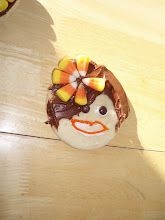Whenever I really like something, I try to learn how to make it myself so I can enjoy it whenever I fancy. One treat that I became quickly addicted to is
zaatar bread. Popular in the Arabian Peninsula and Middle East,
zaatar (also written as
za'tar) is a mixture of various dried herbs, usually ground thyme, oregano, marjoram, sumac, toasted sesame seeds, and salt. Each region, country, and specific household will prefer their own blend.
My first try of
za'tar bread was at a lovely Middle Eastern restaurant in NYC called Moustache (see link under "Recently Dined At"). While not exclusively vegetarian, there are enough options to fill even the hungriest vegetarian diner. In addition to
za'tar, they have humus, felafel, foul, and other dishes that either have been or will probably be featured here on this blog.
Spice markets are easy to come by in NYC, and there is a well stocked one in Hell's Kitchen that sold
za'tar in bulk (I will update this post with the exact location and name of this place once I remember it). To make your own
za'tar bread the easy way, simply by the spices from a reputable shop, get some fresh pita, and good extra virgin olive oil. As your oven pre-heats, pour a generous amount of olive oil on your pita, smear it around with your fingers (or use a pastry brush if you don't want soft hands0, and then liberally sprinkle the spices on top. Cook in the oven until the bread is hot and the olive oil is bubbling.

Being in the Arabian Peninsula, I was not surprised to see
za'taron the menus at at the market. I found two different varieties at Tamimi's, purchasing the greener one, saving the reddish version for another day. I made my own
za'tar bread here in my dorm-like kitchen, with ok results. The bread here is called
khubz and is thinner than your traditional pita, but is just as tasty. I need to adjust the time due to the thickness of the bread, along with the fact that I'm using and electric oven.
Another
khubz-based item that I am in love with is
labneh with honey. Trusty Mama Noura was my introduction to this item on their "pastry" section.
Labneh is a very thick yogurt, even thicker than that Greek yogurt all the kids are eating now. This paste is oven eaten with bread and served weet or savory - sweet with honey and savory with
za'tar. At Mama Noura, they smear the
labneh on their freshly baked
khubz, drizzle honey on top, and cook it in the oven and roll it up. This is one of the best things I have ever eaten - warm, comforting, sweet, filling, and very simple. Simple enough to even make in a dorm-like kitchen?
At my last grocery outing, I got the courage to belly up to the deli counter. Overwhelmed with the choices of
labneh, olives, and various pickled items, I asked for the Turkish variety for no reason other than it was one of the lower priced plain varieties. I bought my freshly baked bread from the bakery section and honey from the condiment isle. The honey took a bit of time, as I wanted to purchase local honey and many of the jars were imported from the USA, Australia, and countries in Europe. I finally found a jar that was produced in Jeddah, Saudi Arabia.
Like my
za'tar bread making experience, I didn't have the electric oven temperature mastered. However, it was not a bad first attempt.







































